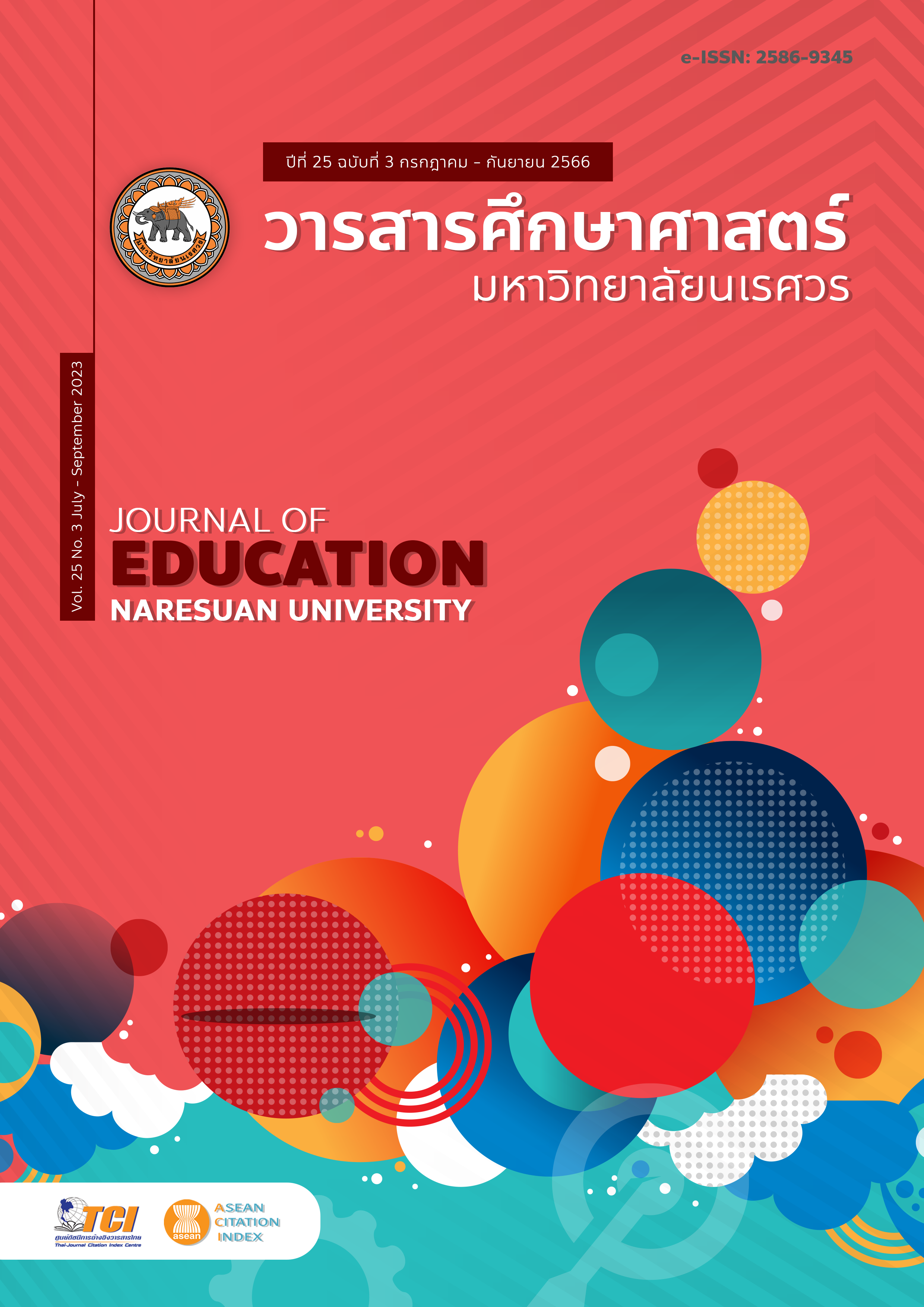FACTORS AND INDICATORS FOR CULTIVATING SCIENCE TEACHER IDENTITY OF THAI TEACHERS องค์ประกอบและตัวบ่งชี้ในการเสริมสร้างอัตลักษณ์ความเป็นครูวิทยาศาสตร์ของครูไทย
Main Article Content
Abstract
This research aimed to identify the components and indicators of the science teacher identity (STI) of Thai teachers. This study employed an exploratory sequential mixed-methods research design. The study was divided into two phases. Phase 1 aimed to explore factors and indicators of STI of Thai teachers by collecting data from systematic review and interviewing 5 outstanding science teachers in Thailand. The data were analyzed by using content analysis. Phase 2 aimed to investigate the consistency of confirmatory factor in the science teacher identity model. The samples were 472 secondary science teachers in OBEC schools. The research instrument was the questionnaire of STI. Its Item-Objective Congruence scores were 0.57-1.00 and its reliability coefficient was 0.86. The data from the questionnaire were analyzed by second order confirmatory factor analysis using LISREL program 8.53. The result indicated that science teacher identity was cultivated by eight components which covering forty-two indicators. They were: 1) personal experience related to science (PES); 2) knowledge and skills (KSK); 3) attitudes towards science teacher career and science teaching (AST); 4) Believes and Values (BVL); 5) motive and representation (MRP); 6) self-professional learning, and learning and development in a community (SPD); 7) desired outcomes (DOC); and 8) cultural and social expectations (CSE). The structural model of Thai teachers’ science teacher identity fitted well with the empirical data (Chi-square = 1756.34, CFI = 0.98, NFI = 0.96, RMR = 0.02, RMSEA =.05, PNFI = .89, CN = 256.13). The components which had highly impact on the science teacher identity were BVL(1.00), DOC(.99) and AST(.91), respectively. This result provides guidance to science educators and curriculum developers striving to enhance science teacher identity of Thai teachers into higher level.
Article Details

This work is licensed under a Creative Commons Attribution-NonCommercial-NoDerivatives 4.0 International License.
The owner of the article does not copy or violate any of its copyright. If any copyright infringement occurs or prosecution, in any case, the Editorial Board is not involved in all the rights to the owner of the article to be performed.
References
Adams, J. D., & Preeti, G. (2017). Informal science institutions and learning to teach: An examination of identity, agency, and affordances. Journal of Research in Science Teaching, 54(1), 121–138.
Avraamidou, L. (2014). Developing a reform-minded science teaching identity: The role of informal science environments. Journal of Science Teacher Education, 25, 823–843.
Avraamidou, L. (2016). Studying Science Teacher Identity: An Introduction. In L. Avraamidou (Ed.), Studying Science Teacher Identity: An Introduction (pp. 1 – 14). Rotterdam, The Netherlands: Sense Publishers.
Beauchamp, C., & Thomas, L. (2009). Understanding teacher identity: an overview of issues in the literature and implications for teacher education. Cambridge Journal of Education, 39(2), 175 – 189.
Bennett, J., Lubben, F., Hogarth, S., & Campbell, B. (2004). A systematic review of the use of small-group discussions in science teaching with students aged 11-18, and their effects on students’ understanding in science or attitude to science. In: Research Evidence in Education Library. London: EPPI Centre, Social Science Research Unit, Institute of Education
Chi, H. J. (2009). Development and examination of a model of science teacher identity (STI) (Doctoral dissertation). Columbus, OH: The Ohio State University.
Creswell, J. W., & Plano Clark, V. L. (2011). Designing and conducting mixed methods research (2nd ed.). Los Angeles: Sage Publications.
Hair, J. F., Black, W. C., Babin, B. J., & Anderson, R. E. (2010). Multivariate data analysis (7th ed.). Pearson: New York.
Hong, J., & Vargas, P. (2016). Science teachers’ perception and implementation of inquiry-based reform initiatives in relation to their beliefs and professional identity. International Journal of Research Studies in Education, 5(1), 3-17.
Intawong, B., Prachanban, P., & Kanjanawasee, S. (2017). The development of an evaluation model for the characteristics of the student teachers quality: applying the utilization-focused evaluation. Journal of Education Naresuan University, 19(4), 144-156. [in Thai]
Joreskog, K. G., & Sorbom, D. (1996). LISREL 8: User’s reference guide. Chicago, IL: Scientific Software International.
Ketsing, J., & Roadrangka, V. (2010). A case study of science teachers’ understanding and practice of inquiry-based instruction. Kasetsart Journal of Social Sciences, 31, 1–16. [in Thai]
Langka, W. (2020). Process of incubation for the characteristics of Thai teachers in a decade of transformative learning for student teachers in the faculty of education. Journal of Research and Curriculum Development, 10(1). 247 – 266. [in Thai]
Laorlurtluckkana, K., Chakkaew, W., & Phongsak,S. (2016). Parent’s expectations in regard to administrative learning for the primary level of education in Lampang Province. Journal of Yala Rajabhat University, 11(1), 89 – 101. [in Thai]
Luft, A. J., & Hewson, W. P. (2014). Research on Teacher Professional Development Programs in Science. In Abell, S.K. and Lederman, N.G. (Eds.). Handbook of Research on Science Education (Second Edition), (pp. 889-910).
Plubjeen, K., & Kaemkate, W. (2014). A latent class analysis of teachers’ professional identity. An Online Journal of Education, 9(2), 597 – 611. [in Thai]
The institute for the Promotion of Teaching Science and Technology [IPST]. (2019). PISA2018 results (Volumes48): What 15-year-old students know and can do. Bangkok: The institute for the Promotion of Teaching Science and Technology. [in Thai]
Webster, J., & Watson, R. T. (2002). Analyzing the past to prepare for the future: Writing a literature review. MIS Quarterly, 26(2), 13-23.


